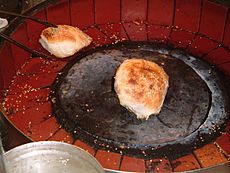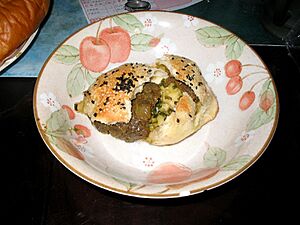Hujiao bing facts for kids

Hujiao bing right out of the oven
|
|
| Course | Snack |
|---|---|
| Place of origin | Fuzhou, Fujian, China |
| Region or state | Fujian, Taiwan |
| Main ingredients | Flaky biscuit-like bread, sugar, soy sauce, white pepper or black pepper, and scallions |
Hújiāo bǐng, also known as a pepper bun, is a yummy baked bun from Fuzhou, a city in Fujian province, China. It's a popular street food that you can find all over Taiwan, especially in busy night markets.
These tasty buns have a crispy outside and a juicy filling. The dough is made from flour, water, and a special ingredient that helps it rise. Inside, you'll find meat, usually pork or beef, seasoned with sugar, soy sauce, lots of pepper, and fresh scallions.
Contents
Where Did Hújiāo Bǐng Come From?
It's not totally clear who first invented the hújiāo bǐng. This delicious bun is found in both Fujian, China, and in Taiwan. Many people in Taiwan call it the "Fuzhou Pepper Bun." They believe it was first made by people who moved to Taiwan from Fuzhou. Some of the oldest shops selling these buns were started by families with roots in Fuzhou.
How Is Hújiāo Bǐng Made?
Making a Hújiāo bǐng starts with the dough. It's made from flour, water, and something like yeast or baking powder to make it soft. Sometimes, a little lard, butter, or oil is added. This makes the bun super crunchy and flaky, almost like a croissant, when it's cooked. Each piece of dough is rolled out into a thin, round shape, much like a dumpling wrapper.
The main part of the filling is meat, usually pork. The meat can be ground up or sliced into thin pieces. Some chefs use both ground and sliced meat to give the bun a nice texture. Ground meat is often preferred because it creates more delicious juice when baked. The meat is seasoned with plenty of white or black pepper, soy sauce, sugar, and cooking wine. Some places also add five-spice powder or curry powder for extra flavor.
After the meat is spread on the dough, fresh green scallions are placed on top. It's important to add the scallions separately, not mixed into the meat. This way, you get a clear, fresh scallion taste in every bite. Unlike other buns, the sealed part of the Hújiāo bǐng is at the bottom. Finally, the top of the bun is brushed with water and sprinkled with white sesame seeds.
The buns are baked in a special clay oven. This oven is tall and round, similar to a tandoori oven. Burning charcoal is placed at the bottom to make the oven very hot. The buns are then stuck vertically along the inside walls of the oven, from bottom to top.
When the buns are ready, a flat tool, like a blunt knife, is used to gently scrape them off the oven wall. A special basket is held underneath to catch the hot buns. This stops them from falling into the charcoal at the bottom.
A freshly cooked Hújiāo bǐng has a thin, crunchy crust, almost like a cracker. When you bite into it, delicious meat juices flow out. Because of how the bun is wrapped, the green scallions are usually right in the middle, surrounded by the flavorful meat.
Why Are Pepper Buns So Popular?
Hújiāo bǐng started to become famous outside of Taiwan thanks to TV shows. It was featured on travel shows like Anthony Bourdain's The Layover and Hong Kong's TVB show Neighborhood Gourmet.
Soon, the pepper bun became a must-try food for tourists visiting Taiwan. Many visitors who tasted the bun would write about it online. Because of its popularity, waiting in line to buy a Hújiāo bǐng can take a long time, often 30 minutes or more, especially during busy hours. People often buy several buns at once because of the long wait. If a vendor runs out of ingredients, they usually close for the day instead of making more.
See also
 In Spanish: Hújiāo bǐng para niños
In Spanish: Hújiāo bǐng para niños



